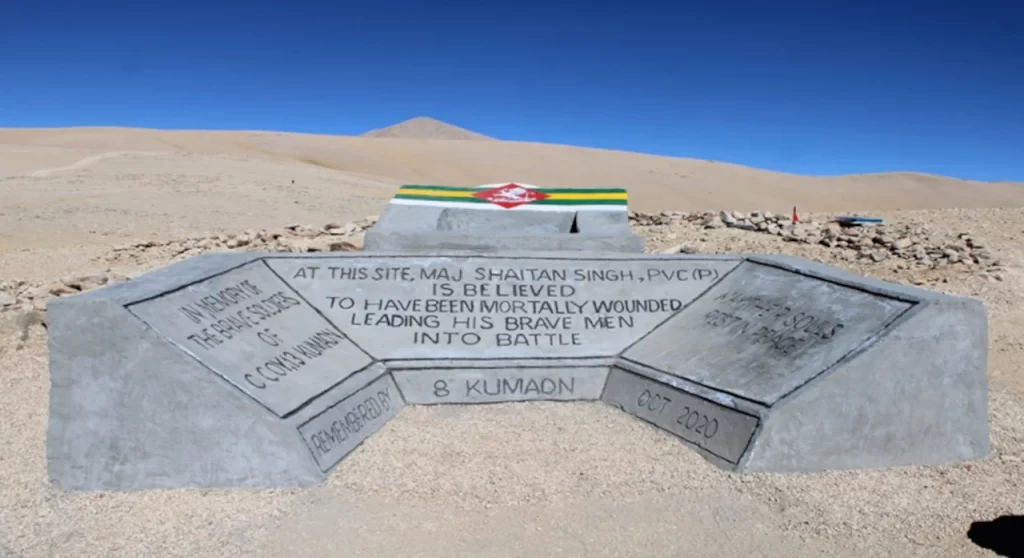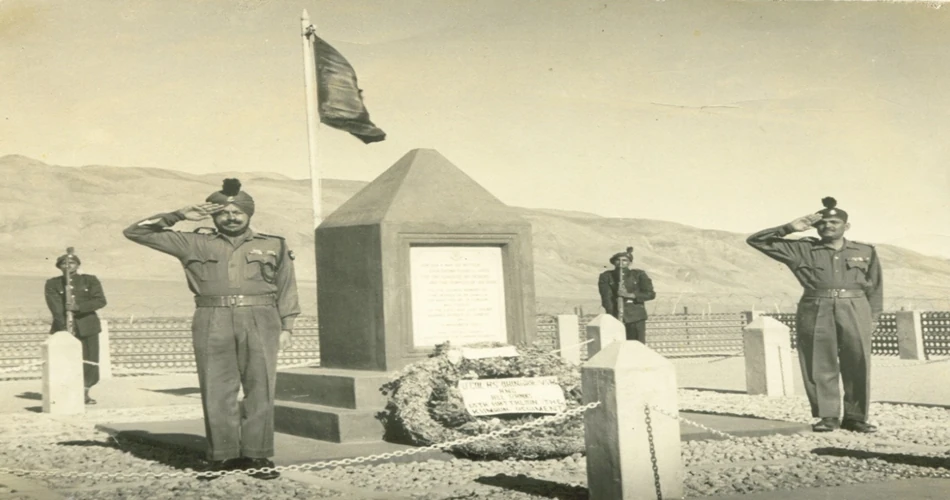Amidst Christmas and New Year celebrations, print and social media were buzzing with the false news apparently spread by
one Mr Konchok Stanzin, a councillor of the Ladakh Autonomous Hill Development Council from Chushul, alleging the dismantling of the Rezang La Memorial constructed by 13 Kumaon in 1963 in the memory of 114 Ahirs of the ‘Charlie’ Company of the Battalion martyred in the epic ‘Battle of Rezang La on November 18 during the Sino-Indian War 1962, by the Army as part of the disengagement process with China. Some videos also posted this news, the Wire and the Telegraph online dated December 28, 2023, by Sujjan Dutta with the headline, ‘Creation of LAC buffer zone forces demolition of 1962 War hero Major Shaitan Singh’s memorial’ is out rightly malicious and only beneficial to our adversaries, harming our national security and interests. Since I was commissioned in 13 Kumaon after the 1962 War and have written profusely on Rezang La Battle, I was most perturbed over this maligned issue under wild circulation.
Numerous military historians have likened the Battle of Rezang La to the renowned battles of Thermopylae, which took place in 480 BC between the Greek and Persian empires, and the legendary battle of Saragarhi, which took place on September 12, 1897, in the North-West Frontier Province. In that battle, twenty-one men from the 36th Sikh Regiment—currently known as the 4th Battalion, the Sikh Regiment—lost their lives in the face of over 10,000 tribal fighters. The photo in wide circulation of the so-called Memorial appended below was built by the regimental sister unit 8 Kumaon in Oct 2020 in Rezang, La, during its tour of duty in Chushul.

A word about the Strategic Importance of Chushul & Rezang La
Stretching from north to south, Chushul is a slender, sparsely inhabited, desolate sandy valley that spans the watershed at 14,230 feet, surrounded by steep mountains. It is 40 km long and 5.6 km wide at its widest point. Only the closest of friends or the bitterest of foes may wish to cross paths on these high passes. It is almost directly adjacent to the Chinese border. Its boundaries are as follows: higher hills rising above 19,000 feet east and west, a weather airfield to the south, and a deep, 160 km long, clear saltwater lake called Pangong Tso (lake) running parallel to the Indus River to the north. The tint of Pangong Tso varies according to the moon and sun’s phases. The entrance to the Spanggur Tso (lake) on the eastern side is known as the Spanggur Gap. It extends well into Chinese territory, just like the Pangong Tso. The tank-capable road from Rudok in Tibet to the Spanggur Gap was constructed by the Chinese prior to the start of the war. One way to go to Chushul from Leh was to cross the Chang La mountain and avoid the Pangkong Lake. Alternatively, one might take a diversion across the pass and head directly east. Chushul served as the hub for all Indian outposts in this area, ranging from Daulat Beg Oldi to Damchok. Although Chushul’s fall wouldn’t have directly threatened the defence of the Ladakh region, its significance at the time affected Indian pride and psyche. The Chinese took advantage of these favourable topography and meteorological conditions in their 1962 operations.
Rezang La is a pass that is part of the Chushul Valley’s southeast approach. The feature has an average elevation of 16,000 feet above sea level, measuring around 3 km long and 2 km wide. Digging fortifications in the stony boulders was very physically and mentally taxing because of the absence of air, the harsh cold, and mechanical digging tools. Men were breathless even after just a few steps since they had not yet gotten used to the high altitude. Our troops had difficulty resting the first few nights because the yaks and ponies in the area had not brought meals, sleeping bags, or woollen gear. A kettle of water took hours to boil, and fresh provisions like onions, potatoes, tomatoes, oranges, etc, were frozen solid, like cricket balls. Rezang La also possessed a grave weakness as it was deprived of vital fire support. The towering mountain crests hampered the flight of artillery shells, negatively impacting artillery firing in the 1962 War. Incidentally, the 13 Kumaon Battalion Headquarters was located at the High Ground. It was here that, a few months later, the bodies of martyrs retrieved from Rezang La were mass cremated. Subsequently, 13 Kumaon built the Rezang La Memorial, approximately 7-8 kilometres from the Rezang La feature.

Genesis of the Issue
We all are aware of the complex border dispute between India and China. Rezang La, like many features along the IB, was never occupied by either side pre-1962 or post-1962 War. India occupied Rezang La as part of the build-up and withdrew after the ceasefire. After the war, both sides patrolled the area, and there was no construction on either side. Post Galwan, we occupied Rezang La to create leverages to counter Chinese actions elsewhere. This is the time out of sheer regimental spirit and motivation, 8 Kumaon constructed the Memorial on October 25 2020, on the spot where Maj Shaitan Singh PVC was assumed to have been mortally wounded when our forces were deployed in the area as part of our aggressive deployment. The commemorative stone had no historical significance and was demolished by 8 Kumaon on February 10, 2021, only as part of the disengagement agreement. Both sides returned to their pre-Galwan locations, and all landforms, including man-made structures, were removed. Since the boundary between India and China is not demarcated and the agreed LAC runs along the crest lines of the heights, both sides honour this understanding in letter and spirit as per agreed protocols, consensus and agreements under the directions of the Central Government.
The construction of the Rezang La Memorial was, as brought out above, completed on August 5, 1963 (the Raising Day of 13 Kumaon) at High Ground in Chushul as brought out earlier and renovated and inaugurated on November 18, 2021, in Chushul by Defence Minister Raj Nath Singh in a well-attended function that must have been known or perhaps attended by Mr Konchok Stanzin too, who had resigned from the BJP over differences on the status of UT, Ladakh. Being a prominent local public figure, he must know all such facts. Spreading false information or rumours is not conducive to our national security and diplomacy, our armed forces’ morale, and combat effectiveness. It’s time we pride our war memorials as ‘temples of our gods’ that, besides motivating posterity, should be great tourist attractions.

An excellent piece by Col Nini Bhatia.
He was commissioned in 13 KUMAON – Bravest of the Brave Battalion.I have known him over the years.
Our battalions served together in the Congo Brigade.Much later,I was fortunate to have this Battalion in my formation – where they were awarded an Ashok Chakra & brought Honour,Fame & Glory to the formation.
He writes regularly on geo-strategic & geo- political imperatives impacting South Asia with particular focus on India.
He is a profilic writer & also a specialist & advisor on matters industrial security.
It is a pity that all sorts of half-baked views are reported by ‘so-called defence specialists’ that distort the true narrative.
I commanded my Battalion in Chushul & have a hands on knowledge about the terrain configuration- right from DBO till Rezang La & around.Descriptions given by Col Bhatia are totally correct & meticulously brought out.
I did not come across any ridge by the name of Kailash Ridge !May be,a ridge was given this name much later.
Compliments.